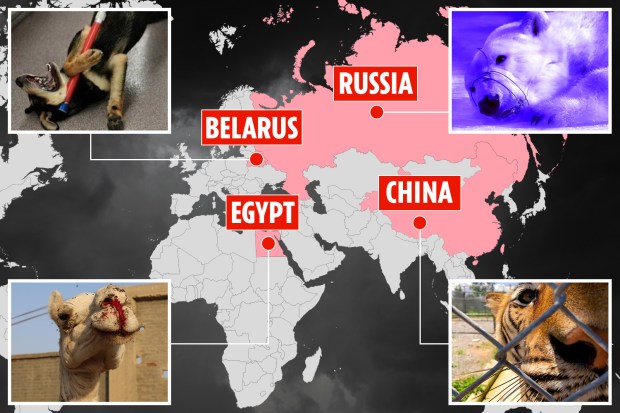Across the globe, the maltreatment of animals manifests in stark and unsettling ways. As we strive to create a more compassionate world, it’s crucial to explore and understand the regions where animal cruelty is rampant. This discourse delves into the most inhumane countries for animals, examining systemic practices that perpetuate suffering and igniting a discussion on accountability and reform. Can we truly say we are civilized while such atrocities persist? The challenge lies in not only recognizing the severity of the issue but also in mobilizing action against it.
When assessing animal welfare, various factors emerge as indicators of systemic cruelty. These include, but are not limited to, the strength of animal protection laws, cultural attitudes towards animals, and socioeconomic conditions. Countries that lack comprehensive legal frameworks tend to allow rampant abuse, often in the guise of tradition or economic necessity. Instances of egregious cruelty may vary in form—from industrial farming practices that prioritize profit over welfare to the abhorrent acts of violence inflicted upon companion animals.
In many developing regions, the exploitation of animals extends beyond individual suffering to encompass systemic issues of poverty and lack of education. For instance, in some countries, stray dogs face horrific fates, often being subjected to cruel practices simply to control their population. The widespread belief that such brutality serves a purpose only underscores the deep-rooted misconceptions surrounding animal rights. Cultural norms that dismiss animal welfare as secondary to human concerns reflect a disheartening reality, often sidelined in the discourse surrounding human advancement.
Countries with minimal regulation in animal welfare reveal a troubling acceptance of cruelty, prompting questions about the societal values that uphold such practices. For example, in parts of Southeast Asia, animals are frequently subjected to inhumane treatment for food and entertainment. Bear bile farming stands as a prominent example, where bears are confined to small cages, subjected to painful extraction methods for their bile, an ingredient believed to have medicinal properties. The inhumane conditions they endure raise ethical concerns and highlight the disconnect between consumer demand and animal rights.
Moreover, the prevalence of “exotic” pets can lead to horrific outcomes for animals bred in abhorrent conditions. In countries where wildlife trafficking is rampant, many species are endangered by the insatiable demand for exotic pets. Animals captured from their natural habitats often endure horrifying transportation conditions, leading to significant suffering and high mortality rates. This practice not only harms individual animals but also disrupts entire ecosystems—a crime against both animal and environmental integrity.
Changing the narrative around animal rights necessitates collaborative efforts that transcend borders. Animal welfare organizations in various parts of the world are making strides in advocacy, education, and reform. However, translational efforts often face formidable obstacles, including governmental resistance, cultural pushback, and financial constraints. Nevertheless, campaigns that focus on increasing public awareness have shown promise. The rise of social media platforms has enabled activists to galvanize support, drawing international attention to local abuses and sparking conversations about ethical treatment.
It is essential to consider the role of legislation and enforcement in combating cruelty. Nations like Finland, Sweden, and Germany have implemented stringent animal welfare laws and made remarkable progress in reducing cruelty levels. Such models underscore the effectiveness of regulatory frameworks in protecting animals. In contrast, countries lacking these measures frequently face crises of abuse, with little recourse for intervention or protection for mistreated animals. The challenge remains—how do we persuade nations with lax regulations to adopt progressive animal welfare standards?
The sentiment surrounding animal cruelty is evolving, thanks in part to an increased focus on sustainability and ethical consumption. The awareness of how animal treatment relates to overall environmental health adds an additional layer to the conversation. The interconnectedness of animal rights, environmental sustainability, and human welfare creates a compelling case for integrating humane practices into societal norms. Advocating for animal rights is not merely an ethical imperative; it also serves as a crucial component of global ecological health.
In embarking on discussions surrounding the countries where cruelty prevails, it is vital to acknowledge the interconnectedness of these issues. Violence against animals does not occur in a vacuum; rather, it is symptomatic of broader societal failures that warrant attention and reform. Efforts to abolish such practices often encounter resistance, revealing deep-seated beliefs that need to be actively challenged. As we continue to navigate these complex dynamics, one must ask: what role do we, as global citizens, play in advocating for change?
As we bear witness to the suffering of voiceless beings across the planet, let that knowledge inform our actions. Engaging in advocacy, educating ourselves and others, and supporting organizations committed to animal welfare can lead us to a more compassionate world. The journey towards eliminating cruelty knows no borders, and the momentum for change is only as strong as our collective resolve. We possess the ability to challenge the status quo, foster empathy, and pave the way for a future where animals are treated with dignity and respect.






